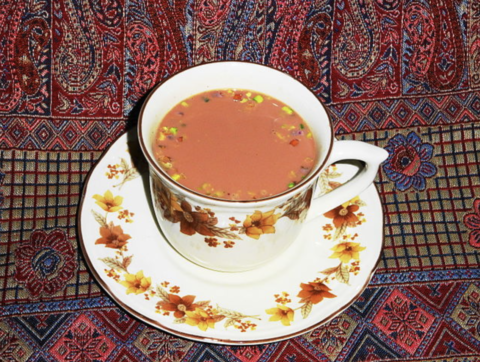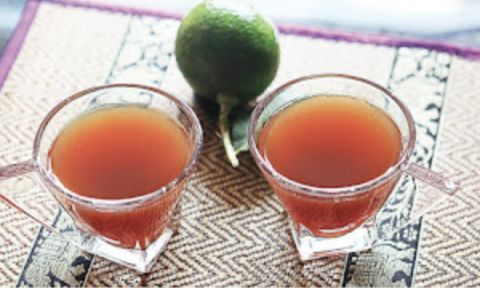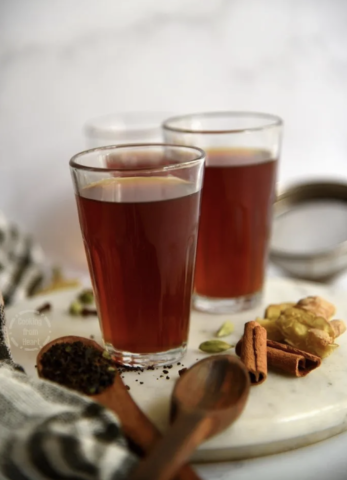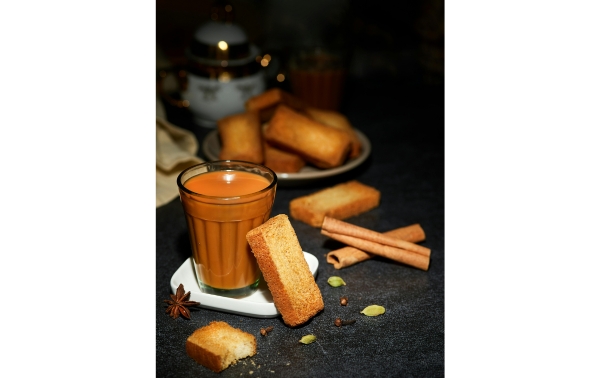Indians and Chai have an age-old relationship. Whether it be an all nighter before board exams or neighborhood gossip-story, it can be hard to imagine without chai! Yet, the story of chai itself is not often told.
In ancient India, chai referred to a healing concoction made from herbs and spices, similar to traditional kada. This early version of chai didn’t contain any tea leaves and varied in recipes according to the seasons and available ingredients. Legend has it that chai was discovered by accident when a Buddhist monk in China, observing locals chewing on wild leaves, tried it himself and found it rejuvenating. This discovery led to the introduction of tea in India.
Tea’s historical roots in India extend to Assam, where the Singhpo tribe used tea leaves as medicine as far back as the 12th century. The British discovered the assamica variety of tea in Assam in 1823, leading to the establishment of tea plantations in the region. The addition of milk to tea likely originated from traders and travelers from Gujarat, Maharashtra, and Bengal, who had access to good quality milk. This led to the development of masala chai, a spiced tea served with sweet or savory toast, blending Indian and British traditions. Despite initial resistance, tea became a staple in Indian culture, with various regions and communities adapting it to their tastes. The CTC (cut, tear, curl) method of making tea, invented by William McKercher, made tea more affordable for the masses. McKercher observed that traditional methods of processing tea leaves, such as rolling them by hand, were time-consuming and labor-intensive. He experimented with different techniques and eventually developed the CTC method, which involved cutting, tearing, and curling the tea leaves using mechanical rollers. This process not only reduced the processing time but also produced a more uniform and consistent tea product. This long journey of chai, beginning as a medicinal concoction to a daily delight, stirring in its British, Indian and Chinese traditions, became a story of every Indian.
Ronga Saah: Assam’s Red Tea:
When the word “tea” is mentioned, one of the first places that comes to mind is Assam, renowned for its beautiful tea gardens. In Assamese, “Ronga Saah” translates to red tea or Lal Cha, owing to the rich, reddish-brown hue of this beloved brew. Unlike traditional chai, Ronga Saah is enjoyed without milk, often paired with a touch of honey or sugar.
This variety of tea, along with its rich flavor, is very popular in regards to its digestive properties. One of the key characteristics of Assam’s red tea is its high levels of antioxidants, which are believed to have several health benefits, including aiding digestion and reducing the risk of certain diseases. Additionally, the tea is low in tannins, which can help reduce acidity, making it a good choice for individuals with sensitive stomachs. Depending upon the region, there are variations in the ways in which it is prepared. In Assam and Sikkim, it’s common to enhance the flavor with honey, adding sweetness and aroma.
Honey, favored over sugar, adds its own health benefits and complements the mild, soothing taste of Lal Cha. The tea leaves used for Ronga Saah are carefully selected and cultivated, contributing to its light yet revitalizing flavor. To an Assamese, Ronga Saah is akin to espresso for coffee lovers: bold, concentrated, and efficient, yet sweet, aromatic, and soothing. Ronga Saah, made from fresh, luxurious tea leaves steeped in boiling water, embodies Assam’s tea culture, inviting all to savor its distinctive taste and invigorating properties.
Sources:
- Red And Relaxing: Have You Tried Assam’s Ronga Saah Tea?
- Why The Assamese Can’t Do Without Ronga Saah AKA Red Tea – Curly Tales
- ‘I despise English tea’: Bridgerton snub spotlights India’s national …
Kashmiri Noon Chai:
Kashmir’s noon chai is one of the most popular varieties of tea in India. Known for its distinctive pink hue, this tea, also called Gulabi Chai or Sheer Chai is cherished for its flavor and presentation. The term “noon” translates to salt in several Indian languages including Koshur (Kashmiri), Bengali, Hindi, and Rajasthani, making “noon chai” literally “salt tea.” Typically enjoyed in the mornings and afternoons, noon chai is often accompanied by naan or tschot. It is prepared by boiling Kashmiri or green tea leaves in water. The addition of baking soda or sodium bicarbonate is a key factor, as it reacts with the tea leaves during brewing, imparting a rich ruby color to the liquid. The brewed tea is then vigorously beaten and aerated to incorporate air, further enhancing its pink hue. Other flavoring ingredients, such as green cardamom and star anise, are added for aroma and taste. The addition of milk and salt at the end transforms the liquid into the characteristic pink shade.

While traditional green tea can be used, gunpowder tea is preferred for its unique flavor profile. Gunpowder tea is made by rolling young tea leaves into small pellets, resembling grains of gunpowder. This tea variety, with its smoky flavor, adds to the distinctiveness of Kashmiri noon chai.
Sources:
- Kashmiri Style Noon Chai Recipe – Pink Tea – Archana’s Kitchen
- Kashmiri Chai or Noon Chai (Pink Tea) – Mirchi Tales:
- Kashmiri Noon Chai Recipe – Times Food:
- Kashmiri Noon Chai: How to Perfect Your Cup of the Pink Tea:
- Noon chai: How to make this traditional Kashmiri pink tea
Lebu Cha: Kolkata’s Spiced Lemon Tea:
West Bengal, has a strong tradition of tea consumption influenced by British colonial history. Lebu Cha, a cherished beverage from Kolkata, offers a unique twist to the traditional lemon tea. Infused with a blend of spices known as “Moshla,” this tea captivates the taste buds with its refreshing and tangy flavor profile. The combination of rock salt, cumin seeds, carom, and black pepper sets Lebu Cha apart, making it a favorite among Kolkatans. Originating in the bustling streets of Kolkata, Lebu Cha has become a staple in the daily lives of locals. It is often enjoyed in the mornings, paired with savory biscuits or samosas, adding a delightful start to the day. Street vendors carrying kettles and spice boxes offer this aromatic tea, adding to the city’s vibrant charm.

Beyond its delicious taste, Lebu Cha offers several health benefits. The spices in this tea aid in digestion and provide relief for cough and cold symptoms. The addition of lemon, particularly the fragrant gondhoraj lemon or pati lebu, boosts the immune system with Vitamin C.
To make Lebu Cha at home, you’ll need water, black tea leaves or tea bags, honey or sugar, gondhoraj lemon or pati lebu, rock salt, cumin seeds, carom seeds, and black pepper. Boil water, add tea leaves, lemon juice, spices, and simmer for a few minutes. Add honey or sugar to taste, strain into cups, and enjoy your homemade Lebu Cha. With its unique flavor and health benefits, Lebu Cha has become a beloved part of the city’s culinary heritage.
Sources:
- Lebu Cha: Moshla Lemon Tea From Kolkata | Miniaturefoodie
- LEBU CHA- Kolkata street style “Masala Lemon Tea” | Wandering Eyes
- Food Walk Through North Calcutta With A History Lesson – India Food Network
- Lemon Tea – Spice and Colour
Sulaimani Chai: A Unique Blend of Sweet and Sour from Kerala:
Sulaimani chai, a sweet-sour tea originating from Kerala, India, is a refreshing departure from traditional teas. Unlike its milk-infused counterparts, Sulaimani chai is made with black tea and served without milk. It is brewed to a pure golden color and flavored with sugar and a hint of lemon, with additional spices like cloves, cardamom, and cinnamon often added for a flavorful twist. Occasionally, you may even find a basil or mint leaf enhancing its aroma.

Legend has it that Sulaimani chai’s roots trace back to the Prophet Muhammad, who is said to have savored this concoction. Over time, the Arabian world embraced this tea, adding sugar to the original recipe. Today, Sulaimani chai remains popular in places like Dubai, where it can be found in almost every tea shop.
In Kerala, Sulaimani chai holds a special place in the culinary landscape, often served after heavy meals like biryani as a digestive aid. It is also a symbol of hospitality, frequently offered to guests. This tea has even made its mark in the Kerala film industry, appearing in movies like Ustad Hotel, where it plays a role in bringing characters closer together.
Beyond its culinary appeal, Sulaimani chai has inspired acts of kindness. Operation Sulaimani, a food program initiated in Kozhikode, Kerala, aims to eliminate poverty by allowing customers in cafes to pay for an extra cup of coffee or tea, which is then provided to underprivileged individuals. This initiative has received widespread support and has expanded to other districts in Kerala. Sulaimani chai’s popularity extends beyond Kerala, with Hyderabad being another hotspot for this tea, known locally as ghava. In Mumbai, it can be found in Irani cafes and upscale tea houses, each offering its own unique take on this beloved beverage.
While Sulaimani chai can be enjoyed at various establishments, it is also simple to make at home. Using Assam or Darjeeling tea, boil a teaspoon of tea leaves with sugar and a stick of cinnamon. After boiling, let it steep before adding a squeeze of lime. This homemade version captures the essence of Sulaimani chai, making it a delightful treat for any tea enthusiast.
Sources:
- Sulaimani Chai: An Unusual Sweet and Sour Tea from Kerala
- History and a Cup of Sulaimani: The Story of an Unusual Tea From Kerala
- A Suleimani Story! – Kerala Insider
- Sulaimani Chai | Local Tea From Kerala, India – TasteAtlas
Darjeeling Tea:
Darjeeling’s unique flavor and aroma make it stand out among teas, earning it the nickname “Champagne of Tea.” Grown in the Himalayan region, Darjeeling tea is known for its light body and fruity notes, reminiscent of muscatel grapes. Unlike most black teas, Darjeeling black tea is less oxidized, resulting in a lighter and less astringent taste. The aroma of Darjeeling tea is floral, with a delicate flavor featuring hints of apricot and peach, making it a truly exceptional tea.
Darjeeling tea is harvested in three main periods known as flushes: First Flush, Second Flush, and Autumnal Flush. Each flush has its unique characteristics, influenced by factors like soil, climate, and elevation.
First Flush, harvested in spring, is known for its briskness and delicate flavors. Second Flush, harvested in summer, has a more robust body and muscatel character. Autumnal Flush, harvested in autumn, produces a full-bodied tea with a fruity flavor.
The terroir of Darjeeling, including its high altitude, cool climate, and unique soil conditions, contributes to the tea’s exceptional flavor. The region’s tea estates, such as Castleton, Glenburn, and Margaret’s Hope, are renowned for producing some of the finest Darjeeling teas in the world.
To experience the unique flavors of Darjeeling tea, it’s recommended to purchase from reputable sources that offer teas from renowned estates. Darjeeling tea is truly a treasure for tea connoisseurs, offering a delightful and sophisticated tea-drinking experience.
Sources:
- Darjeeling tea – Wikipedia
- Darjeeling Tea
- What Is Darjeeling Tea? – The Spruce Eats
- Darjeeling Tea: The Champagne of Teas with a Muscatel Flair
By – Raghav Saluja
